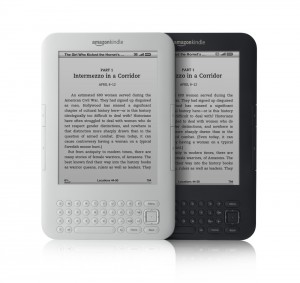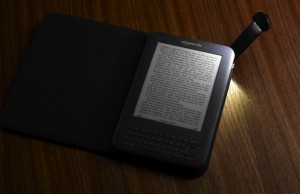
When Apple announced the iPad earlier this year, some commentators declared that it signalled the demise of Amazon.com’s Kindle e-reader.
Unlike the Kindle, which could do only one thing well — display electronic text — the iPad was a multifunctional device, allowing people to browse the Web, check their e-mail, read magazines, watch movies, listen to music and run a universe of applications.
How did Amazon respond? Many might have expected it to release a tablet computer of its own. But, no, its CEO, Jeff Bezos, instead unveiled a new line of improved e-readers, the Kindle 3 series. And he slashed the price.
The new prices — just US$139 for a Wi-Fi-only version and $189 with cellular wireless — have hit the sweet spot for consumers. The Kindle 3 is in such strong demand that if you want one, you’ll have to join a growing waiting list as Amazon’s suppliers can’t keep up with demand.
It’s easy to see why the new Kindle is proving so popular. This third-generation device has largely perfected what was already a very compelling e-reader.
Other than the same screen real estate (six inches), the new Kindle is significantly smaller, thinner and lighter than its predecessor. The 240g device also comes in “graphite” grey, a great alternative to the kitchen appliance-like white-only version it came in previously.
The white version is still available, but we much prefer the graphite option. One wonders why Amazon is so conservative in the colour department. Surely consumers would snap up red and blue and green Kindles, too?
The Kindle has been improved in other ways, too. The electronic ink display is crisper than previous versions. And buttons have been cleaned up so the whole package looks a lot neater.

The keyboard isn’t ideal, though, especially for people with chunkier fingers. It’s easy to press the wrong button, and the “joystick” navigation buttons are too close the “menu” and “back” buttons. Too often, we found we brought up the menu when we meant only to navigate up through a list.
The other big improvement in the new Kindle is the speedier processor, which makes page turning noticeably quicker. Skipping to the next page is quicker than turning a page in physical book, as it should be.
The Kindle 3 charges via a computer’s USB port. Charging takes about six hours or so. A wall charger, which juices the battery faster, is sold as an optional extra. Battery life is excellent. The battery will easily last several weeks on a single charge — Amazon says to expect up to a month. That’s long enough for most holidays and business trips.
Unlike the iPad, which has a backlit screen, the Kindle’s screen is designed for lengthy periods of reading. The e-ink means your eyes won’t quickly get tired as they do with backlit displays. And the device runs cool, so there’s none of the discomfort users experience from many tablet computers and laptops.
The page-turning buttons are located in good positions on both sides of the device, and have been reduced in size, which helps to prevent users from tapping them accidentally. You can flip forward effortlessly, no matter your favourite reading position.
The Kindle 3, which stores about 3 500 books — more space than even the most avid reader could ask for – also has the software features that made previous versions so popular, including a voice menu guider, variable on-screen text size, and the ability to e-mail PDF files and other reading material to yourself.

We sent a fairly complex PDF to our Kindle, and it displayed it effortlessly, images included. Of course, the Kindle doesn’t have a colour screen, so don’t expect the files to look nearly as drop-dead gorgeous as they would on an iPad or other tablet.
Kindle 3 supports PDFs; Microsoft Word files; HTML and plain-text documents; rich text format; and image formats such as Jpeg, Gif and PNG. Amazon warns, however, that some complex PDF and Word .docx files might not format correctly.
The company says its top design objective with the Kindle was to create a device that “disappears” while reading, so people can “get lost in their reading, not the technology”. On that score, the company has succeeded admirably.
The e-ink display remains the real technological marvel here. You can read it in bright sunlight, without the usual glare you get from paper books. But you’ll need a light to read in the dark.
A nice touch is the built-in Oxford dictionary (US and British English versions). That’s a valuable addition on a device that costs as little as $139. There’s also free, built-in access to Wikipedia, though you’ll need an active wireless connection to browse entries.
Experimental software, such as a Webkit-based Web browser and an MP3 player, is also included, though the Kindle is not designed for these tasks. If you want to listen to music on the go, rather get an iPod.
And don’t bother with the text-to-speech option. It still needs a lot of work and is more likely to put you to sleep, or drive you to frustration.
Remember, if you’re going to buy a Kindle, you’ll still be subject to import duties and courier shipping costs.
Our $139 Wi-Fi-only Kindle attracted import duties of $21,41 (you pay this money to Amazon, which then transfers it to the SA Revenue Service). Shipping and handling fees came to $13,49, bringing the total cost to $173,90 — that’s a very affordable R1 260 at R7,25/$.
However, you’ll want to include a leather case for the Kindle, too, not only because it protects the device from scratches, but because it makes it easier to hold, especially when lying in bed.
Though pricey at $60, the “Kindle Lighted Leather Cover” is a great option. It includes a retractable reading light — great for reading in bed without disturbing your partner, or for anywhere where it’s a little too dark to read comfortably. You can bet Amazon is making a fat margin from selling this cover, but it’s really worth the money.
Would we recommend the Kindle? Without a doubt! At the price, it’s a no-brainer. Even if you read only moderately, this is a gadget worth having. It’s not an iPad. But it’s not trying to be. — Duncan McLeod, TechCentral
- Subscribe to our free daily newsletter
- Follow us on Twitter or on Facebook




